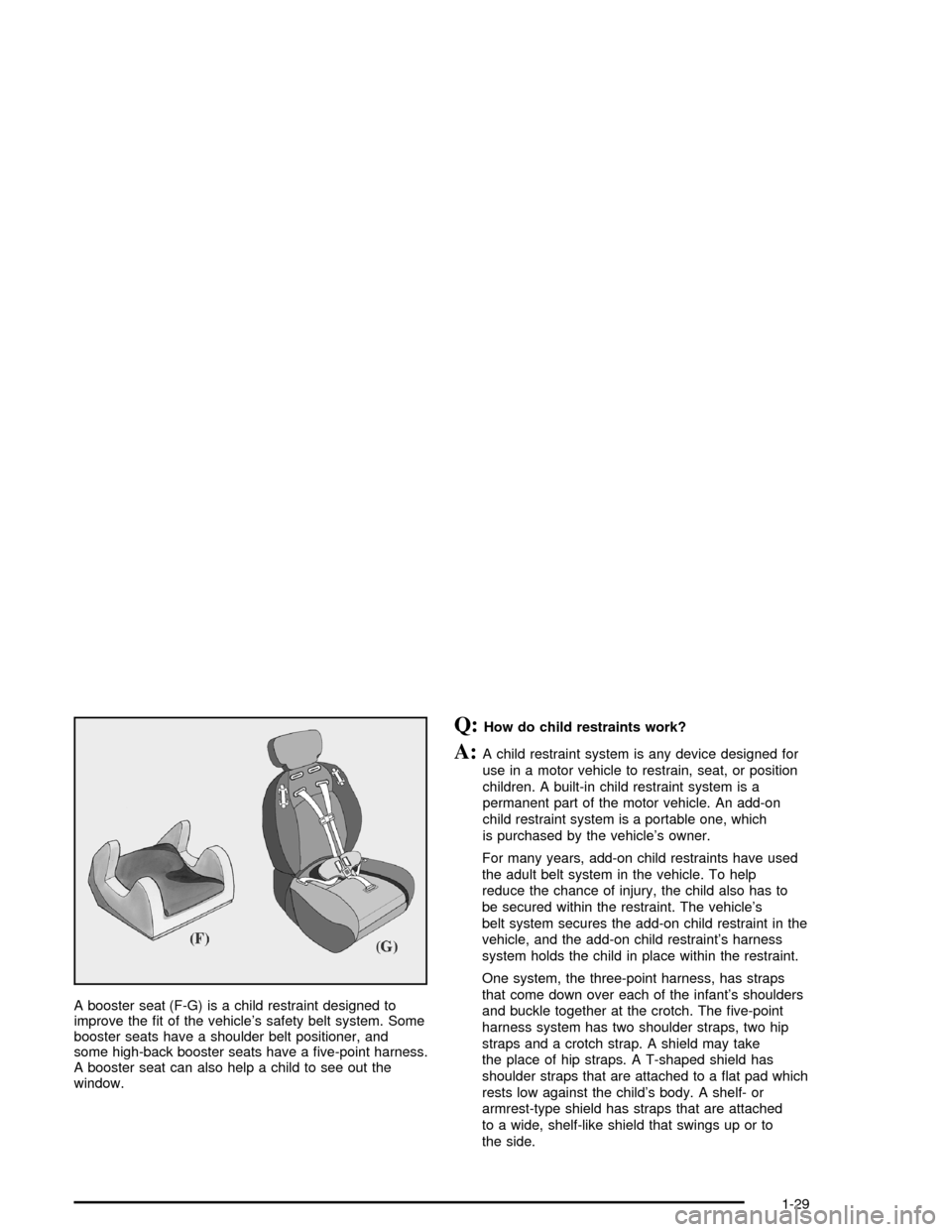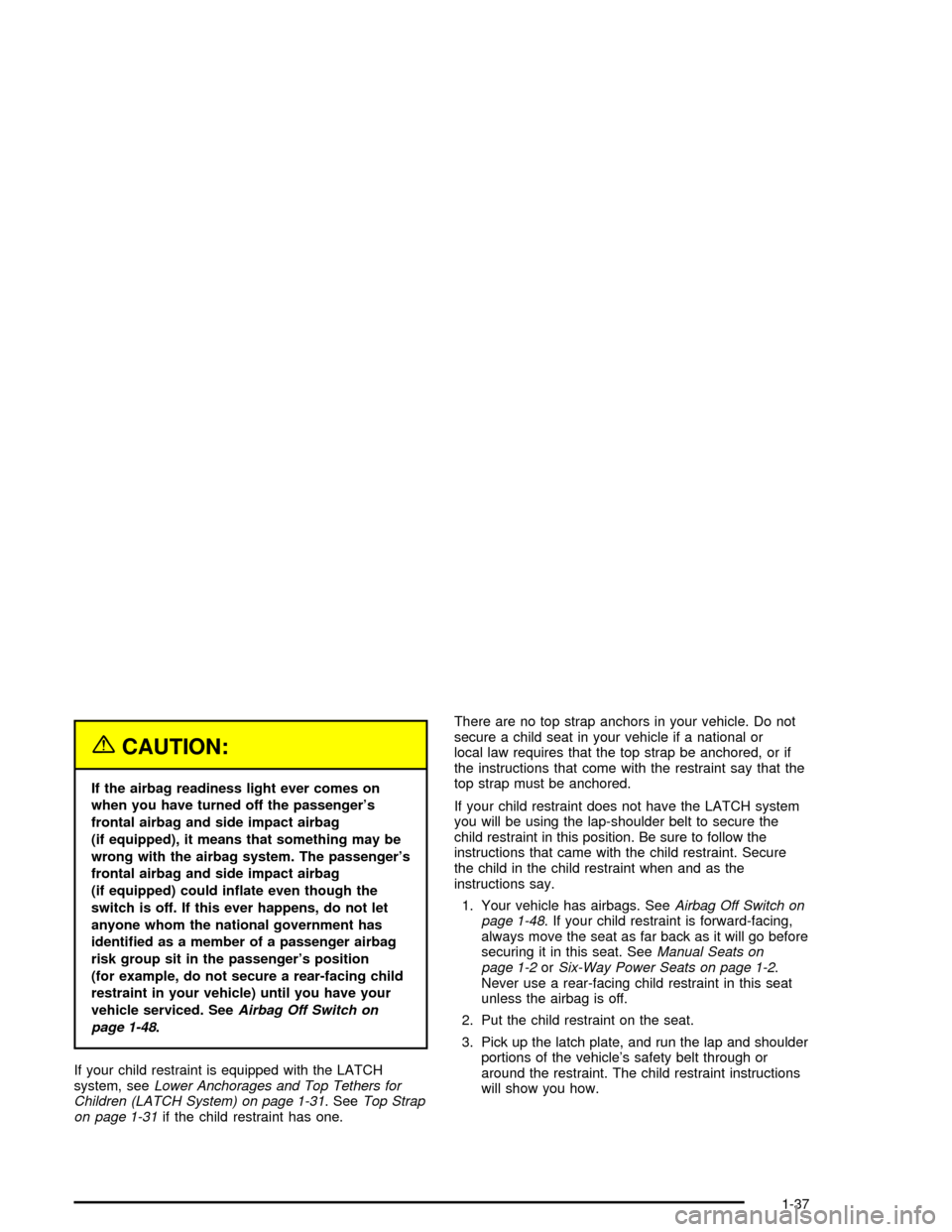2005 CHEVROLET CORVETTE seats
[x] Cancel search: seatsPage 26 of 400

Passenger Position
The passenger’s safety belt works the same way as the
driver’s safety belt. SeeDriver Position on page 1-13.
Safety Belt Pretensioners
Your vehicle has safety belt pretensioners for the driver
and right front passenger. Although you can not see
them, they are located on the buckle end of the safety
belts. They help the safety belts reduce a person’s
forward movement in a moderate to severe frontal and
near frontal crash.
Pretensioners work only once. If they activate in a
crash, you will need to get new ones, and probably other
new parts for your safety belt system. SeeReplacing
Restraint System Parts After a Crash on page 1-52.
Safety Belt Extender
If the vehicle’s safety belt will fasten around you, you
should use it.
But if a safety belt is not long enough, your dealer will
order you an extender. It is free. When you go in to
order it, take the heaviest coat you will wear, so
the extender will be long enough for you. To help avoid
personal injury, do not let someone else use it, and
use it only for the seat it is made to �t. The extender has
been designed for adults. Never use it for securing
child seats. To wear it, just attach it to the regular safety
belt. For more information, see the instruction sheet
that comes with the extender.
1-20
Page 27 of 400

Child Restraints
Older Children
Older children who have outgrown booster seats should
wear the vehicle’s safety belts.
Q:What is the proper way to wear safety belts?
A:If possible, an older child should wear a
lap-shoulder belt and get the additional restraint a
shoulder belt can provide. The shoulder belt
should not cross the face or neck. The lap belt
should �t snugly below the hips, just touching the
top of the thighs. It should never be worn over
the abdomen, which could cause severe or even
fatal internal injuries in a crash.
In a crash, children who are not buckled up can strike
other people who are buckled up, or can be thrown
out of the vehicle. Older children need to use safety
belts properly.
1-21
Page 35 of 400

A booster seat (F-G) is a child restraint designed to
improve the �t of the vehicle’s safety belt system. Some
booster seats have a shoulder belt positioner, and
some high-back booster seats have a �ve-point harness.
A booster seat can also help a child to see out the
window.
Q:How do child restraints work?
A:A child restraint system is any device designed for
use in a motor vehicle to restrain, seat, or position
children. A built-in child restraint system is a
permanent part of the motor vehicle. An add-on
child restraint system is a portable one, which
is purchased by the vehicle’s owner.
For many years, add-on child restraints have used
the adult belt system in the vehicle. To help
reduce the chance of injury, the child also has to
be secured within the restraint. The vehicle’s
belt system secures the add-on child restraint in the
vehicle, and the add-on child restraint’s harness
system holds the child in place within the restraint.
One system, the three-point harness, has straps
that come down over each of the infant’s shoulders
and buckle together at the crotch. The �ve-point
harness system has two shoulder straps, two hip
straps and a crotch strap. A shield may take
the place of hip straps. A T-shaped shield has
shoulder straps that are attached to a �at pad which
rests low against the child’s body. A shelf- or
armrest-type shield has straps that are attached
to a wide, shelf-like shield that swings up or to
the side.
1-29
Page 40 of 400

{CAUTION:
If the airbag readiness light ever comes on
when you have turned off the passenger’s
frontal airbag and side impact airbag
(if equipped), it means that something may
be wrong with the airbag system. The
passenger’s frontal airbag and side impact
airbag (if equipped) could in�ate even though
the switch is off. If this ever happens, do not
let anyone whom the national government has
identi�ed as a member of a passenger airbag
risk group sit in the passenger’s position
(for example, do not secure a rear-facing child
restraint in your vehicle) until you have your
vehicle serviced. SeeAirbag Off Switch on
page 1-48.
There are no top strap anchors in your vehicle. Do not
secure a child seat in your vehicle if a national or
local law requires that the top strap be anchored, or ifthe instructions that come with the restraint say that the
top strap must be anchored.
1. Your vehicle has airbags. SeeAirbag Off Switch on
page 1-48. If your child restraint is forward-facing,
always move the seat as far back as it will go before
securing it in this seat. SeeManual Seats on
page 1-2orSix-Way Power Seats on page 1-2.
Never use a rear-facing child restraint in this seat
unless the airbag is off.
2. Find the LATCH anchorages in the passenger seat.
SeeLower Anchorages and Top Tethers for
Children (LATCH System) on page 1-31.
3. Put the child restraint on the seat.
4. Attach and tighten the LATCH attachments on the
child restraint to the LATCH anchorages in the
vehicle. The child restraint instructions will show you
how. SeeTop Strap on page 1-31if your child
restraint has one.
5. Push and pull the child restraint in different
directions to be sure it is secure.
To remove the child restraint, simply unhook the top
tether from the top tether anchorage and then
disconnect the LATCH anchorages.
1-34
Page 43 of 400

{CAUTION:
If the airbag readiness light ever comes on
when you have turned off the passenger’s
frontal airbag and side impact airbag
(if equipped), it means that something may be
wrong with the airbag system. The passenger’s
frontal airbag and side impact airbag
(if equipped) could in�ate even though the
switch is off. If this ever happens, do not let
anyone whom the national government has
identi�ed as a member of a passenger airbag
risk group sit in the passenger’s position
(for example, do not secure a rear-facing child
restraint in your vehicle) until you have your
vehicle serviced. SeeAirbag Off Switch on
page 1-48.
If your child restraint is equipped with the LATCH
system, seeLower Anchorages and Top Tethers for
Children (LATCH System) on page 1-31. SeeTop Strap
on page 1-31if the child restraint has one.There are no top strap anchors in your vehicle. Do not
secure a child seat in your vehicle if a national or
local law requires that the top strap be anchored, or if
the instructions that come with the restraint say that the
top strap must be anchored.
If your child restraint does not have the LATCH system
you will be using the lap-shoulder belt to secure the
child restraint in this position. Be sure to follow the
instructions that came with the child restraint. Secure
the child in the child restraint when and as the
instructions say.
1. Your vehicle has airbags. SeeAirbag Off Switch on
page 1-48. If your child restraint is forward-facing,
always move the seat as far back as it will go before
securing it in this seat. SeeManual Seats on
page 1-2orSix-Way Power Seats on page 1-2.
Never use a rear-facing child restraint in this seat
unless the airbag is off.
2. Put the child restraint on the seat.
3. Pick up the latch plate, and run the lap and shoulder
portions of the vehicle’s safety belt through or
around the restraint. The child restraint instructions
will show you how.
1-37
Page 133 of 400

The main components of your instrument panel are the following:
A. Air Outlet. SeeOutlet Adjustment on page 3-31.
B. Head-Up Display Controls. SeeHead-Up
Display (HUD) on page 3-20.
C. Turn Signal/Multifunction Lever. SeeTurn
Signal/Multifunction Lever on page 3-8. Cruise
Control. SeeCruise Control on page 3-11. Fog
Lamps. SeeFog Lamps on page 3-17. Headlamp
Controls. SeeExterior Lamps on page 3-15.
D. Driver Information Center (DIC). SeeDriver
Information Center (DIC) on page 3-49.
E. Instrument Panel Cluster. SeeInstrument Panel
Cluster on page 3-33.
F. Windshield Wiper/Washer Lever. SeeWindshield
Wipers on page 3-10andWindshield Washer
on page 3-11.
G. Driver Information Center (DIC) Controls. SeeDIC
Controls and Displays on page 3-49.
H. Center Air Outlets. SeeOutlet Adjustment on
page 3-31.
I. Hazard Warning Flasher Button. SeeHazard
Warning Flashers on page 3-6.
J. Audio System. SeeAudio System(s) on page 3-78.
K. Climate Controls. SeeDual Automatic Climate
Control System on page 3-25.L. Fuel Door Release Button. SeeFilling the Tank on
page 5-7. Hatch/Trunk Release Button. See
“Hatch/Trunk Lid Release” underHatch/Trunk on
page 2-14.
M. Instrument Panel Brightness Control. SeeInstrument
Panel Brightness on page 3-19.
N. Power Folding Top Switch. SeeConvertible Top
(Manual) on page 2-57orConvertible Top (Power)
on page 2-64.
O. Ignition Switch. SeeIgnition Positions on page 2-21.
P. Heated Seat Controls. SeeHeated Seats on
page 1-4.
Q. Shift Lever (Automatic Shown). SeeAutomatic
Transmission Operation on page 2-25orManual
Transmission Operation on page 2-27.
R. Active Handling Button. SeeActive Handling System
on page 4-10.
S. Accessory Power Outlet. SeeAccessory Power
Outlets on page 3-24.
T. Airbag Off Light. SeeAirbag Off Light on page 3-36.
U. Instrument Panel Cupholder. SeeCupholder(s)
on page 2-46.
V. Ashtray and Cigarette Lighter. SeeAshtrays and
Cigarette Lighter on page 3-25.
3-5
Page 159 of 400

Outlet Adjustment
Use the tab located on the air outlets to change the
direction of the air�ow.
Operation Tips
Clear away any ice, snow or leaves from the air
inlets at the base of the windshield that may
block the �ow of air into your vehicle.
Use of non-GM approved hood de�ectors may
adversely affect the performance of the system.
Keep the area around the base of the instrument
panel console and air path under the seats clear
of objects to help circulate the air inside of
your vehicle more effectively.
Passenger Compartment Air Filter
The passenger compartment air �lter removes certain
odor and particles from the air including pollen and dust
particles. Reductions in air�ow, which may occur
more often in dusty areas, indicate that the �lter may
need to be replaced. SeeScheduled Maintenance
on page 6-4for information on how often to replace the
�lter.Notice:Driving without a passenger compartment
air �lter in place can cause water and small
particles, like paper and leaves, to be pulled into
your climate control system which may cause
damage to it. Make sure you always replace the old
�lter with a new one.
The passenger compartment air �lter is located on the
passenger side of the engine compartment near the
battery. SeeEngine Compartment Overview on
page 5-12.
To check or replace the air �lter, do the following:
1. Disengage the passenger compartment air �lter
housing cover retainer clips (1).
2. Remove the passenger compartment air �lter
housing cover.
3-31
Page 178 of 400

2(Gages):Press this button to display gage
information like oil pressure and temperature, coolant
temperature, automatic transmission �uid temperature, if
equipped, battery voltage, and front/rear tire pressures.
TRIP:Press this button to display your total and
trip distance driven, the elapsed time function, your
average speed, and the engine oil life.
OPTION:Press this button to choose personal options
that are available on your vehicle, depending on the
options your vehicle is equipped with, such as door
locks, easy entry seats, and language.
RESET:Press this button, used along with the other
buttons, to reset system functions, select personal
options, and turn off or acknowledge messages on
the DIC.
FUEL Button
The fuel button displays average fuel economy and
instantaneous fuel economy, calculated for your speci�c
driving conditions, and range information.Average Fuel Economy:The average fuel economy is
viewed as a long-term approximation of your overall
driving conditions. You should reset the average
fuel economy display every time you refuel. If you press
the RESET button in this mode while you are driving,
the system will reset this display and begin �guring fuel
economy from that point in time.
Press the fuel button to display average fuel economy,
such as:
AVERAGE FUEL ECONOMY 20.1 MPG or
AVERAGE FUEL ECONOMY 5.3 L/100 km
Instantaneous Fuel Economy:Instantaneous fuel
economy re�ects only the fuel economy that the vehicle
has right now and will change frequently as driving
conditions change. Unlike average fuel economy, this
menu item cannot be reset.
Press the fuel button again to display instantaneous fuel
economy, such as:
INSTANT FUEL ECONOMY 20.1 MPG or
INSTANT FUEL ECONOMY 5.3 L/100 km
3-50